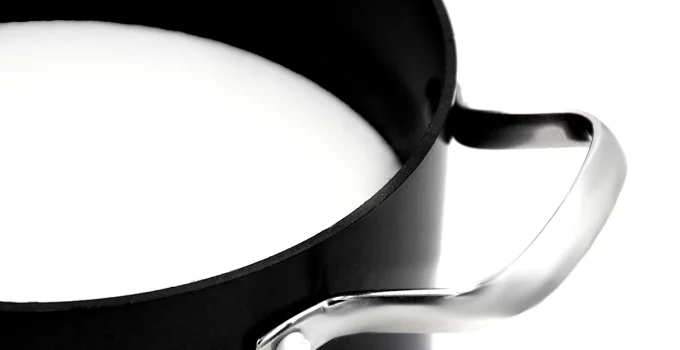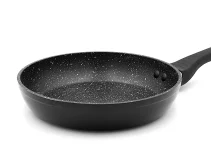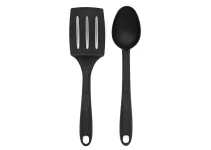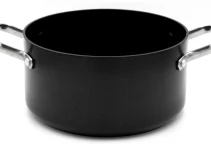To be honest, most pans could be chosen as the best pan to boil milk in. For example, if you have a stock pot, you can definitely use it to boil milk in. Or any saucepan. And the list can go on.
I would say that the main material you must keep away from is cast iron pots. I talked about the fact that we can’t boil milk in cast iron when I answered the question on whether we can boil water in cast iron or not.
Other than that, there are pretty much no limits when we’re looking for the best pans for boiling milk.
It also comes down to a personal preference, whether we prefer our pans and pots to be PFOA/PTFE-free, in which case we might be interested in ceramic cookware or granite cookware.
Or we might prefer stainless steel over other materials. And we might have a certain budget in mind. Things like that.
I’m certainly going to try to cover all preferences and needs by choosing a variety of pans and pots.
Best Pan to Boil Milk Reviews

As I’ve mentioned in my introduction, we’re not really restricted in our use of pots when we’re boiling milk.
Of course, there are also milk pots that we can buy. And I’m definitely going to include a lot of those when I review my picks for the best pot for boiling milk.
Milk pots are usually characterized by a smaller size. And one or two pour spots if you want to add the boiled milk directly to your drinks, to your cereal or to your dishes without spilling any. In that regard, they’re very useful.
However, I also want to include some bigger pots as well. Some of you might want to make cheese at home or yogurt or large batches of desserts, etc.
1. Dcigna Saucepan with Pour Spout, 1.5 Quart: Overall the Best Pan to Boil Milk
This 1.5 quart saucepan with pour spout can be the best pan to boil milk in if you are looking to boil about 4-5 cups of milk.
For example, if we want to prepare some milk for 2-3 bowls of cereal, the 1.5 quart size is good enough.
The size is good enough for making a small amount of soup or sauces.
It can be great if you’re cooking for 2-3 people and you don’t want any leftovers.
It will also be big enough for most desserts. If you make dessert recipes that use a lot of milk, the Dcigna Saucepan with Pour Spout can be the perfect tool.
It also works well for melting butter.
Moreover, it’s great for making ramen, instant noodles, oatmeal, boiling eggs, poaching eggs, etc.
On the other hand, the price is not the cheapest. If you get it on sale, the price is quite decent. Otherwise, it might be a bit expensive.
Features
Let’s see what else we need to know about the Dcigna Saucepan with Pour Spout, besides its 1.5 quart capacity.
It is made with 18/10 food grade stainless steel, which is really awesome.
The interior has a special matte finish to prevent scratches over time. Moreover, I recommend using wooden or nylon utensils when you stir milk or make sauces or any other dishes. Metal utensils can faintly scratch even stainless steel.
The exterior has a mirror finish for a shiny and stylish look.
Another feature I like is that there are easy to read measurement marks inside. It can be helpful when you’re making desserts or other dishes.
This Dcigna Saucepan with Pour Spout also comes with a pretty looking lid. It’s a combination of stainless steel, glass, and some small straining holes.
The lid also has holes. These are helpful if you’re boiling ravioli, dumplings or a small amount of pasta because the holes drain the water, while the lid catches the ingredients.
The handle doesn’t stick out too much, it’s an interesting design but it might also get very hot so be careful.
I should also mention that the pour spout is on the left, which is a regular occurrence for saucepans that only have a single pour spout. It won’t dribble and make a mess.
It is compatible with induction, gas, electric, halogen, and vitroceramic cooktops.
2. Cuisinart Chef’s Classic Open Pour Saucier, 1 Quart
The pretty affordable price, the 1 quart quantity, and the overall quality make this Cuisinart Chef’s Classic Open Pour Saucier a pretty good choice.
I will confess that I’m not the biggest fan of the design. While I usually love black cookware, this saucepan from Cuisinart is not my favorite.
But we’re not here to hand over beauty awards. We’re looking for the best pots for boiling milk and this Cuisinart Chef’s Classic Open Pour Saucier, 1 Quart is definitely a good candidate.
On the other hand, the 1 quart size would be a bit small for me. It’s the equivalent of 4 cups so I’m sure it will be more than enough for some.
Features
The first thing to know is that it has a hard anodized exterior and it promises unsurpassed heat distribution.
The core is made of aluminum, as it’s also the case with stainless steel cookware.
The interior is nonstick, it’s called Quantanium non-stick for professional results.
It seems that the Quantanium coating offers outstanding resistance to scratching, abrasion and wear, while maintaining high levels of release.
The nonstick coating is PFOA-free but not PTFE-free. The two are not the same but the chemistry differences between the two are pretty complicated so I’m not going to go into the whole thing. I personally don’t see much difference between the two anyway. I also don’t shy away from all PTFE cookware.
There are also measurement markings on the inside, which is nice. But they’re a bit hard to make out since the interior is all black.
It comes with a cool grip handle.
And there’s a pour spout on the left for drip-free pouring. It certainly doesn’t drip, which is awesome and one of its top features.
It’s oven safe up to 500 degrees F.
Another thing to pay attention to is that it’s not induction compatible. It works with gas, electric, glass, and halogen cooktops. But there’s no induction compatibility.
It also doesn’t come with a lid.
3. HexClad Hybrid Pot with Glass Lid, 1 Quart
HexClad makes some very expensive pots. I mean, this 1 quart saucepan from them has a price around $100. That’s expensive for such a small pan.
As I’ve mentioned for the Cuisinart that I recommended above, 1 quart is the equivalent of 4 cups. It’s a good size if you want to boil just a bit of milk.
I think it’s a lot of money to spend on a 1 quart saucepan but it’s pretty popular. Thus, I thought that maybe there is someone who would be interested in such a choice for the best pan to boil milk. Personally, it’s not for me but I’m not writing this article for me, I’m writing it for other people.
Features
Let me just tell you this HexClad Hybrid Pot with Glass Lid is one of those saucepans that doesn’t have a spout.
If you’re looking for drip-free pouring, look at the two saucepans that I recommended above.
If you want to pour milk directly into your cereal bowl, you can’t. I recommend using a soup ladle if you want to do it without any mess.
The HexClad Hybrid Pot with Glass Lid is made from two layers of stainless steel and aluminum is used as the core for even heat distribution. It’s a popular construction for stainless steel cookware.
What is different is the hexagon design on the inside. This is a HexClad patented technology that has the purpose to provide both stainless steel and nonstick surface.
It is PFOA-free but there is no mention of being PTFE-free.
The HexClad Hybrid Pot with Glass Lid can be used on the stovetop, it’s induction range-ready, and it is oven safe up to 500 degrees F. It can be used on gas, electric, induction, and in the oven.
It also comes with a stay-cool handle. And it’s dishwasher safe.
However, you should pay attention and read the instructions when you first receive this pot. There’s a bit of seasoning and washing up you must do before using it properly for the first time.
4. All-Clad Stainless Steel Sauce Pan, 3 Quart
There are a few important things All-Clad is known for: high quality and high prices. For this brand, the two go hand in hand.
I must say that I’m not sure how many people go into searching for the best pan to boil milk in and imagine that they’ll end up spending somewhere around $200 or close to it.
I’m well aware that not many would go for that. I totally understand why you wouldn’t either. I mean, there are air fryers or juicers or many other kitchen appliances that don’t cost as much as an All-Clad sauce pan.
On the other hand, if you are willing to spend a high amount of money, All-Clad pans might be on your radar.
Features
Since it’s a saucepan, you should mostly expect that it doesn’t come with a spout. Most saucepans don’t.
This All-Clad Stainless Steel Sauce Pan doesn’t have a spout either. You’ll have to use a soup ladle if we want to avoid making a mess.
I think the 3 quart size is a good choice for those who want to boil a larger quantity of milk.
3 quart is equivalent to 12 cups. It has a bigger capacity, which can be awesome.
I definitely don’t recommend picking this 3 quart pan if you just want to boil a couple of cups of milk.
The 3 quart size also provides versatility.
Besides boiling milk and making sauce, we can also use this stainless steel pan to boil pasta for a big serving or two smaller ones or to make noodles, a bit of soup, a small stew or chili, etc.
However, there are other sizes you can choose from, beside the 3qt option: 1 quart, 1.5 quart, 2 quart, 3.5 quart, and 4 quart.
The All-Clad Stainless Steel Sauce Pan features high, straight sides. It enables the surface to hold heat and to limit evaporation.
This design also assists with stirring a smaller surface area.
It’s perfect for heating liquids.
Quality stainless steel
The quality of the stainless steel used in the making of these pans is impressive.
It’s a classic tri-ply construction: aluminum core bonded together with 2 layers of durable stainless steel all the way around.
This construction ensures fast, even heat distribution.
It’s also oven/broiler safe up to 600 degrees F.
There are also 2 stainless steel handles. And a stainless steel lid to match. The whole design is very pretty and shiny.
It’s also induction compatible. It’s compatible with gas, electric, ceramic and induction cooktops. Stainless steel cookware is great for ceramic cooktops because there’s a lesser risk of scratching a glass cooktop.
5. Cooks Standard Stainless Steel Stockpot
These stockpots from Cooks Standard have two major things going for them: large sizes to choose from and quite affordable prices.
No matter which size you end up picking, you’ll still pay a price well under $100.
Features
We can choose from the following sizes: 8, 9, 11, 20 or 30 quarts.
If you want to boil something like 4 gallons of milk to make cheese, then you’ll have to choose the 20 quarts size.
I find the 30 quarts size to be too big because I don’t see many people boiling such a large volume of milk. But there might be some people who might find it useful even at that very big size.
All the stock pots also come with a solid lid and 2 sturdy handles. We definitely don’t need a lid when we’re boiling milk but it helps with making other dishes.
These big pots are made with brushed 18/10 stainless steel inside and out.
There’s an aluminum disc layered at the bottom. It provides an even/quick temperature distribution. It also prevents hot spots.
It’s compatible with: induction, electric, gas, ceramic, glass, halogen cooktops. It’s also oven safe up to 500 degrees F.
There are also a few use quick tips from the manufacturer:
- use oil or butter but no spray oils
- set heat to low to medium
- let the pan cool before washing
- use wood and nylon utensils
- use a soft sponge for washing
All in all, I think that the Cooks Standard Stainless Steel Stockpot is an awesome choice, especially for people making a large quantity of cheese.
It’s also good for canning, jarring, stewing, and for cooking a big pot of soup for a very large gathering or family.
6. NutriChef Stainless Steel Stockpot
I know that I recommended just above the stockpots from Cooks Standard but I also wanted to review these ones from NutriChef, too.
There are a few differences between these two manufacturers.
NutriChef offers a wide variety of sizes, the diversity is strong: 5, 8, 12, 14, 16, 20, 24, 30, 35, and 40 quarts.
There are a lot of sizes to choose from. Not many would be interested in a 40 quarts pot for boiling milk but who knows.
The other difference is that NutriChef has slightly more expensive stock pots. Thus, if you have a slightly smaller budget, you’re going to prefer the offer from Cooks Standard.
Another thing that intrigued me is that these pots from NutriChef have a very positive review from a professional chef. The pot is good quality, it heats well, the metal is thick and the professional chef mentioned that the pot will be in their regular use equipment for years to come.
Features
All these NutriChef Stainless Steel Stockpots are made with high quality stainless steel. They feature an 18/8 non-reactive stainless steel interior for superior performances.
Each pot also comes with strong riveted handles. And a lid.
It is compatible with gas, induction, and ceramic cooktops.
It’s great as a boiling pot or a soup pot. Of course, it can also be used for canning.
How to Boil Milk: Short Guide & Tips
The major thing we want to completely avoid when boiling milk is for the milk to spill all over our stovetop.
In order to do that, you must stay close to the stove throughout the whole thing. Well, you can leave during the first minutes but you need to keep an eye on your pot.
Another thing you should do is to set the heat on low. You can’t rush through it and it’s quite a quick process so you won’t lose your patience.
If you’re confident in your pot that the milk won’t stick to the bottom and if you stay close to the stove, you can boil it on high heat, as well.
Do you need to stir the milk while it heats up?
Not necessarily.
I just leave it to boil slowly all on its own but you can stir it while it heats up if it makes you feel better.
Use a wooden utensil to stir into the milk, especially if you have a nonstick pan. Even if we boil in a stainless steel pan, metal spoons can still make small surface scratches.
One last thing you must do is to turn the heat off as soon as you see bubbles that indicate it’s boiling.
The thing with milk is that once it reaches its boiling point, it will inflate like a balloon and overflow the confines of the pan. That’s why it’s crucial to turn off the heat as soon as you see bubbles, you’ll notice them first around the walls of the pan.
If you continue to stir as it cools down, you’ll prevent the milk from forming that thin layer of skin on top. I just let it cool down on its own because I enjoy eating that milky skin, I love it.
How long does it take for milk to boil?
I’ve never really timed the whole process of boiling milk. We buy milk from farmers so it’s always bought in larger quantities because we make cheese and yogurt and boil a lot to have for cereal, smoothies, desserts, etc.
Thus, the time it takes for me to boil a large volume of milk is totally different from the time it takes someone who boils a couple of cups in a small pan.
The time it takes to boil milk also depends on its temperature. If you’ve kept it in the fridge for a few hours, it’s going to take longer.
If you’re only boiling a small quantity, you might just need 2-3 minutes and you’re done.
On the other hand, if you’re boiling a large volume, it can take 8-12 minutes.
How to prevent milk from sticking to the pan
I mostly use stainless steel pots, whether I’m boiling milk, boiling water, making soups, etc. I think they’re some of the best options.
The milk doesn’t stick to stainless steel but I have some very reliable stainless steel cookware. Originally, they were my mother’s pots and they’re awesome.
Plus, I gave you plenty of picks for the best pan to boil milk if you want to always boil milk without burning it.
According to this article, stainless steel is also hygienic for milk and food. Stainless steel keeps the freshness of the milk intact. That’s one of the reasons why this material is used by the milk industry.
Moreover, stainless steel is a material that lasts a very long time. We can use the same pan for maybe decades to come.
Stainless steel has good endurance against temperature change, impact and erosion.
Although, the secret is in boiling it over low heat and making sure that you keep an eye on it so it doesn’t inflate like a balloon spilling all over your cooktop.
Another tip that I haven’t tried myself because my pots don’t cause any problems is to rinse inside the pan with cold water. Don’t dry out the pan. Actually, leave about a tablespoon of water in the pan.
This trick with leaving a bit of cold water in the pan it’s supposed to work because the water will form a protective layer between the milk and the pan.
All in all, I hope that by purchasing the best pan to boil milk you’ll find the process of boiling milk quick and effortless.




